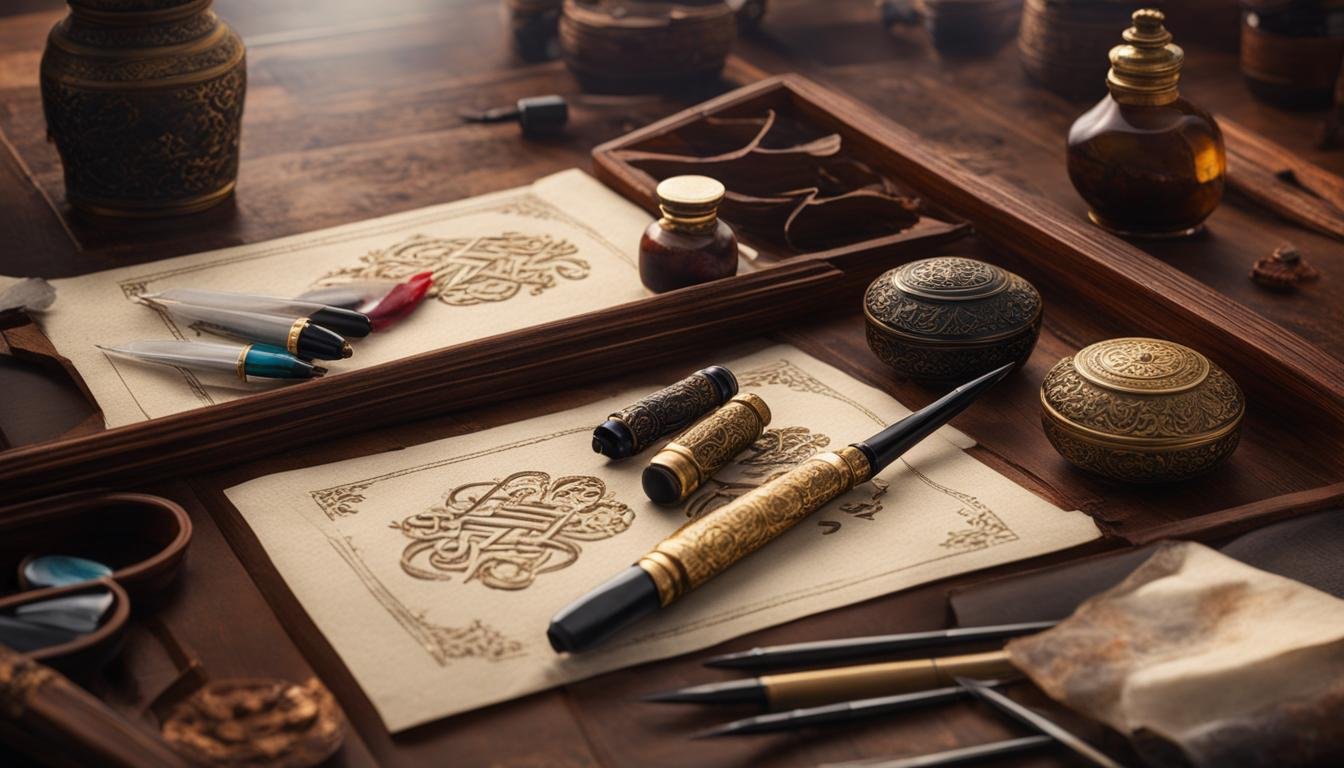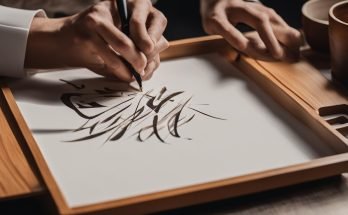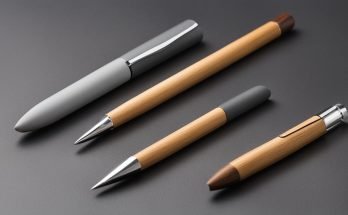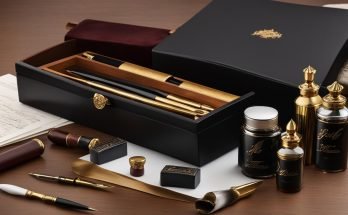Traditional Calligraphy Sets Unleashed: Discover the Secret to Stunning Handwritten Masterpieces!
Welcome to the captivating world of traditional calligraphy sets! These exquisite tools have been cherished by artists and enthusiasts for centuries, and they continue to inspire creativity and stunning craftsmanship. With a variety of pens, nibs, inks, and papers at your disposal, traditional calligraphy sets offer endless possibilities for creating beautiful and intricate lettering.
Whether you are a seasoned calligrapher or just beginning to explore this timeless art form, investing in high-quality traditional calligraphy sets is a must. These tools not only elevate your artistic process but also allow you to express your unique style and create stunning masterpieces that stand the test of time.
Key Takeaways:
- Traditional calligraphy sets are cherished tools used for creating beautiful and intricate lettering.
- Nibs and pen holders are essential components of a calligraphy set, determining the thickness and style of the lines created.
- The choice of ink and paper is crucial for achieving optimal results in calligraphy.
- There is a wide range of calligraphy pens and inks available, catering to different styles and preferences.
- Investing in high-quality calligraphy supplies enhances the creative process and helps achieve timeless calligraphic results.
Nibs for Calligraphy

When it comes to traditional calligraphy, the nib is an essential tool that determines the thickness and style of the lines you create. Whether you’re a beginner or an experienced calligrapher, having a variety of nibs in your collection allows you to experiment with different techniques and achieve the desired effect. Let’s explore some popular nibs that are widely used in calligraphy.
Nikko G
The Nikko G nib is an excellent choice for beginners. It is a sturdy and reliable nib that provides smooth and consistent ink flow. With a medium flex, it allows for control and precision when forming letters. The Nikko G nib is particularly suitable for modern calligraphy styles and can create both thick and thin lines with ease.
Hunt 101
The Hunt 101 nib is a versatile option that is favored by many calligraphers. It is known for its flexibility, which allows you to create a wide range of line widths. Whether you’re working on intricate lettering or expressive flourishes, the Hunt 101 nib delivers consistent results. Its responsiveness to pressure makes it suitable for both calligraphy and drawing projects.
| Nib | Description |
|---|---|
| Nikko G | A sturdy nib suitable for beginners, provides smooth and consistent ink flow. |
| Hunt 101 | A versatile nib favored by many calligraphers, offers flexibility and responsiveness to pressure. |
Having a selection of nibs like the Nikko G and the Hunt 101 in your calligraphy toolkit ensures that you have the right tools to bring your artistic vision to life. Experimenting with different nibs allows you to explore various calligraphy styles, create unique designs, and enhance your overall calligraphy skills. So, whether you’re just starting or looking to expand your nib collection, consider these popular options for your next calligraphy project.
Pen Holders for Calligraphy
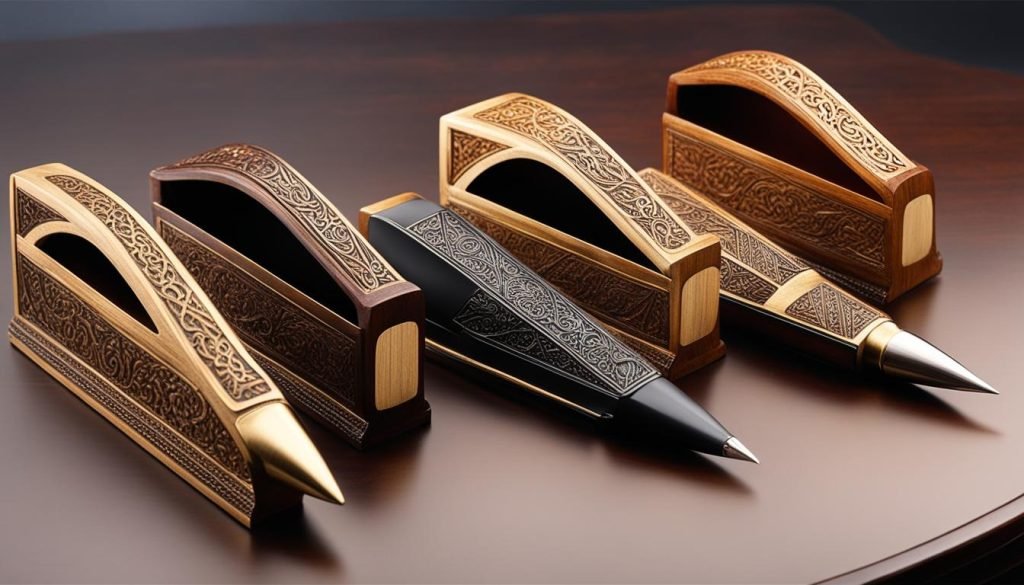
When it comes to traditional calligraphy, the right pen holder can make a world of difference in your writing experience. Pen holders provide a comfortable grip and stability for the nib, allowing you to create smooth and precise strokes. Whether you are a beginner or a seasoned calligrapher, choosing the right pen holder is essential for achieving beautiful lettering.
One popular type of pen holder is the oblique pen holder. These pen holders feature a slanted design, which allows for a more natural writing angle. They are ideal for calligraphers who use pointed nibs and want to achieve consistent slant in their lettering. Oblique pen holders are available in various materials and designs, from elegant wooden holders to sleek and modern plastic holders.
If you prefer a more straightforward and affordable option, straight pen holders are a great choice. These pen holders have a straight design and provide a comfortable grip for the nib. They are especially suitable for beginners who are just starting their calligraphy journey. Straight pen holders are available in different materials, including plastic, wood, and metal, giving you a range of options to choose from based on your personal preferences.
Comparison of Oblique and Straight Pen Holders
| Pen Holder Type | Design | Grip | Suitable for |
|---|---|---|---|
| Oblique Pen Holder | Slanted design | Provides a natural writing angle | Calligraphers who use pointed nibs and want consistent slant |
| Straight Pen Holder | Straight design | Provides a comfortable grip | Beginners and calligraphers who prefer simplicity |
Remember, the pen holder you choose is a personal preference, so it’s always a good idea to try out different types and designs to find the one that feels most comfortable and suits your calligraphy style.
Whether you opt for an oblique pen holder or a straight pen holder, both options can enhance your calligraphy experience and help you achieve beautiful and precise lettering. Experiment with different pen holders and find the one that allows you to unleash your creativity and create stunning calligraphy pieces.
Best Ink for Pointed Pen Calligraphy
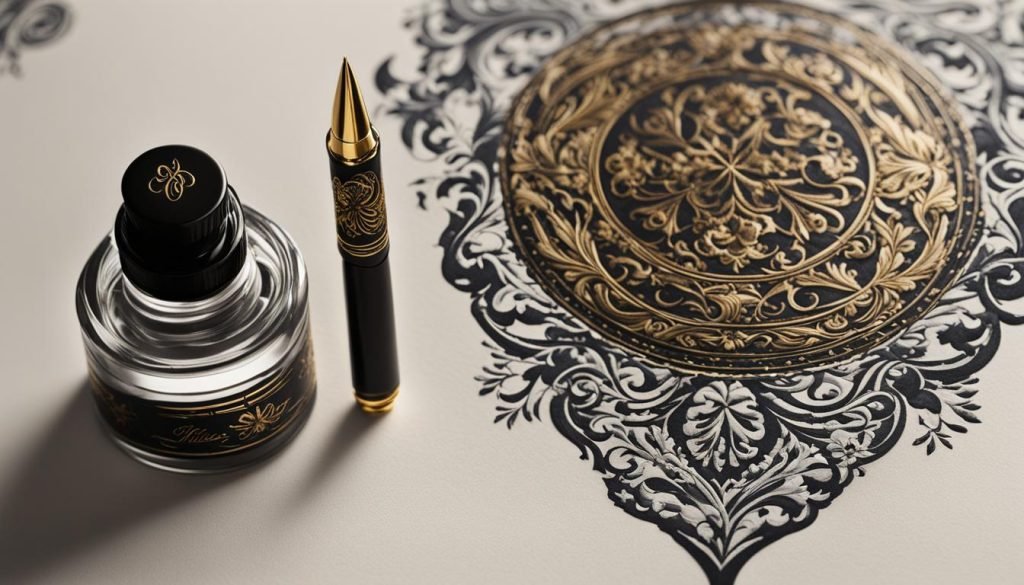
When it comes to pointed pen calligraphy, choosing the right ink is essential for achieving the best results. The ink you use can greatly impact the overall look and feel of your calligraphy pieces. There are several options available, each with its own unique qualities and characteristics.
1. Sumi Ink
Sumi ink is a popular choice among calligraphers for its rich color and smooth flow. Made from soot and mixed with gum, it provides excellent opacity and a beautiful shine when dry. Sumi ink works well with pointed pen nibs and can also be used with Pilot Parallel pens. It is especially recommended for beginners due to its forgiving nature and versatility.
2. Walnut Ink
Walnut ink is another great option for pointed pen calligraphy. It has a thinner consistency and a lovely sepia color, reminiscent of traditional calligraphy. Walnut ink creates a different aesthetic compared to sumi ink, giving your calligraphy pieces a vintage and timeless look. It is also known for its quick-drying property, which can be advantageous for faster work.
3. Dr. Ph Martin’s Bleedproof White
Dr. Ph Martin’s Bleedproof White ink is a must-have for calligraphers who want to create stunning lettering on black or colored paper. This opaque white ink provides excellent coverage and contrasts beautifully against dark backgrounds. It is perfect for adding highlights, special effects, or intricate details to your calligraphy pieces. However, it is important to note that this ink is not suitable for use with fountain pens and is best used with dip pens or brushes.
These are just a few of the best inks available for pointed pen calligraphy. Each ink offers its own unique qualities and effects, allowing you to explore different styles and create beautiful pieces of art. Take the time to experiment and find the ink that suits your preferences and projects the best. Remember, practice makes perfect, so keep honing your skills and enjoy the process of creating with the best ink for pointed pen calligraphy.
| Ink | Features | Recommended Use |
|---|---|---|
| Sumi Ink | Rich color, smooth flow, excellent opacity | Pointed pen nibs, Pilot Parallel pens |
| Walnut Ink | Thinner consistency, sepia color | Creating vintage and timeless look |
| Dr. Ph Martin’s Bleedproof White | Opaque white, excellent coverage | Black or colored paper |
Don’t Forget the Paper

When it comes to calligraphy, the right paper can make all the difference in achieving beautiful and precise lettering. Selecting the appropriate calligraphy paper is crucial for maintaining straight lines and consistent angles. Smooth papers with guidelines are especially helpful for beginners, ensuring accuracy and providing a helpful reference for letter sizing.
A popular choice among calligraphers is to use copperplate guide sheets, which can be downloaded and printed onto high-quality paper or marker paper. These guide sheets feature slanted guidelines that assist in achieving the desired slant and create a balanced and professional look. The guidelines also help in mastering letterforms and maintaining consistent spacing between letters.
| Calligraphy Paper | Features |
|---|---|
| Smooth Papers with Guidelines | Ensure straight lines and consistent angles |
| Copperplate Guide Sheets | Aid slant consistency and letterform mastery |
When choosing calligraphy paper, it’s important to select a weight that is substantial enough to prevent ink from bleeding through. Thin paper can result in ink feathering and damage to the nib. Opting for a paper that has some thickness and is specifically designed for calligraphy use will help you achieve the best results.
If you prefer to work with colored or black paper, it’s important to choose an ink that is compatible with those surfaces. Some inks are specially formulated to stand out on dark or colored paper, allowing you to experiment with different tones and create unique calligraphy pieces.
Summary:
- Choose calligraphy paper with guidelines for accuracy and reference.
- Consider using copperplate guide sheets for consistent slant and spacing.
- Opt for paper that is thick enough to prevent ink bleeding through.
- Select inks that are compatible with colored or black paper for unique effects.
Calligraphy Pens
When it comes to calligraphy, the right pen can make all the difference in achieving clean and beautiful lettering. There are various types of calligraphy pens available, each offering unique features and benefits. Whether you’re a beginner or a seasoned calligrapher, choosing the right pen is essential for creating stunning results.
One popular option for calligraphy is the Pilot Parallel pen. These pens feature rigid, folded metal nibs that offer the convenience of a fountain pen with the versatility of broad calligraphy nibs. The Pilot Parallel pens are available in different sizes, allowing you to create various line widths and styles. They are user-friendly and suitable for both beginners and experienced calligraphers.
If you prefer a traditional fountain pen style, there are calligraphy pens specifically designed for this purpose. These pens often come with interchangeable nibs of different sizes, allowing you to customize your writing style. They offer smooth ink flow and precise control, making them perfect for detailed and intricate calligraphy work.
| Calligraphy Pen | Features |
|---|---|
| Pilot Parallel Pen | Rigid, folded metal nibs; available in different sizes; user-friendly |
| Traditional Fountain Pen | Interchangeable nibs; smooth ink flow; precise control |
Calligraphy markers are another option for beginners or those who prefer convenience. These markers come with brush-like tips that mimic the strokes of a calligraphy brush. They are easy to use and require less maintenance compared to dip pens or traditional fountain pens. Calligraphy markers also come in a wide range of colors, allowing for creative and vibrant calligraphy projects.
When choosing a calligraphy pen, consider your skill level, the style of calligraphy you want to achieve, and your personal preferences. Experimenting with different pens and nibs can help you discover the one that feels most comfortable and produces the best results for your calligraphy journey.
Key Takeaways:
- There are various types of calligraphy pens available, including Pilot Parallel pens, traditional fountain pens, and calligraphy markers.
- Pilot Parallel pens offer the convenience of a fountain pen with the versatility of broad calligraphy nibs.
- Traditional fountain pens allow for interchangeable nibs and precise control over ink flow.
- Calligraphy markers are beginner-friendly and come in a wide range of colors for vibrant projects.
- When choosing a calligraphy pen, consider your skill level, desired style, and personal preferences.
Inks
Inks play a crucial role in calligraphy, adding depth and personality to your lettering. There are a variety of inks available, each with its own unique properties. When choosing calligraphy inks, consider factors such as color, consistency, drying time, and compatibility with your tools.
Table:
| Ink Type | Features |
|---|---|
| India Ink | – Deep black color – Suitable for dip pens – Not recommended for fountain pens |
| Sumi Ink | – Made from soot and mixed with gum – Ideal for traditional calligraphy styles – Can be used in Pilot Parallel pens |
| Chinese Stick Ink | – Traditional ink for Chinese calligraphy – Comes in solid form, needing to be ground and mixed with water before use |
| Colored Inks | – Offers a wide range of colors for artistic projects – Can be used with different calligraphy tools – Experiment to create unique effects |
Experiment with different inks to discover your preferred style and achieve the desired effect in your calligraphy. Remember to always follow the manufacturer’s guidelines for best results and proper care of your inks.
Choosing the Right Ink
When selecting inks for calligraphy, it’s important to consider the medium you will be working on and the overall aesthetic you want to achieve. Some inks, like India ink, are best suited for traditional dip pens due to their viscosity and suitability for absorbent papers. On the other hand, Pilot Parallel pens and other fountain-type calligraphy pens require inks with a thinner consistency to flow smoothly through their nibs.
- Consider the type of calligraphy you will be practicing. Different scripts may require specific ink characteristics to achieve the desired effect.
- Pay attention to the drying time of the ink. Some inks dry quickly, which may be advantageous for preventing smudging, while others may take longer to dry, allowing more time for blending and shading techniques.
- If you plan to work on colored or dark papers, look for inks that offer good opacity and contrast to ensure legibility.
By exploring various inks and experimenting with different techniques, you’ll be able to create calligraphy pieces that truly stand out.
Writing Surfaces
When it comes to calligraphy, the choice of paper and writing surface is essential for achieving the best results. Different surfaces can affect the flow of ink and the overall appearance of your calligraphy. In this section, we will explore various options for calligraphy paper, including vellum and parchment.
Calligraphy Paper
Calligraphy paper is specially designed to enhance the performance of your calligraphy tools. It is typically smooth and provides guidelines to help you maintain straight lines and consistent angles. There are several types of calligraphy paper available:
- Watercolor paper: This type of paper is ideal for wet media, such as watercolor and ink. It has a slightly textured surface that adds depth to your calligraphy.
- Cartridge paper: Cartridge paper is smooth and suitable for a wide range of calligraphy styles. It is often used for practice and informal projects.
- Bleed-proof marker paper: This type of paper is specifically designed to prevent ink bleeding and smudging. It is great for projects that require clean lines and precision.
- Layout paper: Layout paper is translucent and works well for tracing and transferring designs. It has a smooth surface, allowing your pen to glide effortlessly.
- Tracing paper: Tracing paper is lightweight and transparent, making it ideal for practicing and experimenting with different lettering styles.
It is important to choose a paper that is not too thin to prevent ink bleeding and damaging the nib. Experimenting with different types of calligraphy paper can help you find the one that suits your style and preferences.
Vellum and Parchment
Vellum and parchment are traditional writing surfaces that have been used for centuries. These materials offer a unique texture and aesthetic for calligraphy projects. Vellum is made from animal skins, while parchment is made from treated animal hides. Both vellum and parchment are durable and long-lasting, with a natural resistance to ink smudging.
Using vellum or parchment can give your calligraphy a distinct and timeless look. They are often used for formal invitations, certificates, and other special projects. It is important to note that working with vellum and parchment requires some additional care and technique. They are not as forgiving as paper when it comes to mistakes and corrections.
Other Tools and Materials
While the main tools of traditional calligraphy are essential, there are other materials that can aid in creating precise and beautiful lettering. These additional tools and materials can enhance your calligraphy experience and help you achieve the desired results. Here are some options to consider:
Pencil and Tracing Paper
Before starting a calligraphy project, it can be helpful to sketch out your design with a pencil on tracing paper. This allows you to plan and refine your lettering before committing to ink. Tracing paper also comes in handy for transferring designs onto different surfaces and can be an excellent tool for practicing and experimenting with various calligraphy styles.
Rulers and Guidelines
To maintain clean and consistent lettering, using rulers and guidelines is highly recommended. Rulers help create straight lines, while guidelines ensure proper spacing and alignment of letters. These tools are especially useful for beginners who are still developing their sense of proportion and precision. With the help of rulers and guidelines, you can achieve professional-looking calligraphy with ease.
Erasers and Masking Tape
Mistakes happen, even to the most experienced calligraphers. That’s where erasers come in handy. Having a good-quality eraser allows you to correct small errors and smudges without damaging the paper. Masking tape is another useful tool for calligraphy projects. It can be used to create clean and straight edges, mask off areas for specific effects, or secure paper in place while working.
Good Lighting
Proper lighting is essential for calligraphy, as it helps you see the details of your lettering and maintain consistency in stroke thickness. Natural daylight or a bright desk lamp with an adjustable arm can provide the ideal lighting conditions. Ensure the light source is not too harsh or creates unwanted glares on your work surface. With good lighting, you can fully appreciate the beauty of your calligraphy and avoid strain on your eyes during long practice sessions.
By adding these additional tools and materials to your calligraphy practice, you can take your lettering skills to the next level. Experiment with different techniques and explore the possibilities that these tools offer. Remember, calligraphy is not just about the final product; it is also a process of self-expression and creativity.
Where to Buy Calligraphy Supplies
When it comes to purchasing calligraphy supplies, there are numerous options available both online and offline. Whether you’re looking for nibs, ink, paper, or complete sets, you’ll find a wide range of choices to suit your needs. Here are some popular sources where you can buy calligraphy supplies:
- Amazon: Known for its vast selection, competitive prices, and fast shipping, Amazon is a convenient option for purchasing calligraphy supplies. You’ll find a variety of brands and products to choose from, along with customer reviews to help you make informed decisions.
- Dick Blick: An art supply store with a strong online presence, Dick Blick offers a comprehensive range of calligraphy supplies. From beginner sets to professional-grade tools, they have everything you need to embark on your calligraphy journey.
- Utrecht: With a focus on quality and craftsmanship, Utrecht is another trusted retailer for calligraphy supplies. They offer a curated selection of pens, inks, paper, and other materials, ensuring that you’ll find high-quality products for your calligraphy projects.
- Jackson’s Art Supplies: If you’re looking for a wide variety of calligraphy supplies from both well-known and independent brands, Jackson’s Art Supplies is a great option. They pride themselves on their extensive range of products and their commitment to customer satisfaction.
Before making a purchase, it’s advisable to read customer reviews and compare prices to ensure you’re getting the best value for your money. Additionally, consider checking out local art supply stores in your area, as they may carry a selection of calligraphy supplies. Exploring different sources can help you find unique and specialized products that cater to your specific calligraphy needs.
Remember, investing in high-quality calligraphy supplies can enhance your creative process and help you achieve beautiful results. Whether you’re a beginner or an experienced calligrapher, having the right tools and materials is essential for creating stunning calligraphy pieces. Take your time to research and choose the supplies that resonate with your style and vision, and let your creativity flourish.
Conclusion
Traditional calligraphy sets and calligraphy supplies offer a world of artistic possibilities for both beginners and experienced artists. By investing in high-quality tools and materials, you can enhance your creative process and create beautiful, timeless pieces of art.
Experimenting with different nibs, inks, and papers allows you to discover your preferred style and unlock the full potential of traditional calligraphy. Whether you’re using a dip pen set, a brush pen, or a fountain-type calligraphy pen, each tool provides a unique experience and allows you to create intricate and stunning lettering.
Remember, practice is key to mastering the art of calligraphy. Take the time to familiarize yourself with your chosen supplies and dedicate regular practice sessions to refine your technique. As you continue to explore traditional calligraphy sets and discover new styles, you’ll develop your own signature approach and create truly remarkable calligraphy.
FAQ
What are the essential tools in a traditional calligraphy set?
The essential tools in a traditional calligraphy set include nibs, pen holders, ink, and suitable calligraphy paper.
What are some popular nibs for traditional calligraphy?
Some popular nibs for traditional calligraphy are the Nikko G, which is great for beginners, and the Hunt 101, which is versatile and suitable for both calligraphy and drawing projects.
What type of pen holders are suitable for calligraphy?
Oblique pen holders are known for their ornate designs and are suitable for both right-handed and left-handed calligraphers. Straight pen holders are a durable and affordable option, ideal for beginners.
What is the recommended ink for calligraphy?
Sumi ink is highly recommended for its opacity and shine when dry. Walnut ink is thinner and has a lovely sepia color, while Dr. Ph Martin’s Bleedproof White is perfect for using on black or colored paper.
What type of paper is best for calligraphy?
Smooth papers with guidelines help maintain straight lines and consistent angles. It is important to choose a paper that is not too thin to avoid ink bleeding and damaging the nib.
What are some other types of calligraphy pens?
In addition to dip pens and brush pens, other types of calligraphy pens include Pilot Parallel pens, fountain-type calligraphy pens, and calligraphy markers.
What are the different types of inks for calligraphy?
Inks come in a variety of types and colors for calligraphy. Some common types include India ink, sumi ink, and Chinese stick inks. Colored inks can also be used for artistic projects.
What are some suitable writing surfaces for calligraphy?
Various types of paper can be used for calligraphy, such as watercolor paper, cartridge paper, bleed-proof marker paper, layout paper, and tracing paper. Vellum and parchment are also options for more traditional calligraphy projects.
What other tools and materials may be useful for calligraphy?
Tracing paper, rulers, erasers, and masking tape are among the items that can aid in creating precise and clean lettering. Good lighting is also important when working on calligraphy projects.
Where can I buy calligraphy supplies?
Calligraphy supplies can be purchased from various online and offline stores. Some popular options include Amazon, Dick Blick, Utrecht, and Jackson’s Art Supplies.

